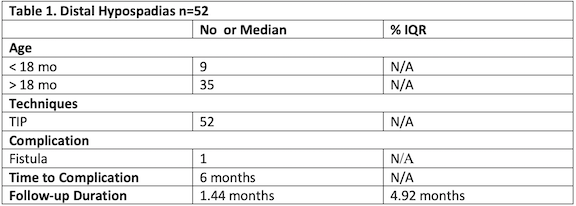Back
Introduction: Teaching hypospadias repair to trainees is a major component of pediatric urology fellowship training but is not a focus of training junior residents. Herein, we reviewed outcomes of distal hypospadias repairs performed by a single surgeon in the proficiency stage of practice in a residency program and compared these outcomes to those for the same surgeon in the same stage in a fellowship program.
Methods: We reviewed all distal tubularized incised plate repairs performed by a single surgeon from 2019-2021. Data included age, meatal location, presence of curvature, operative time, occurrence of complications, and follow-up duration. Of note, resident involvement comprised mainly assisting in penile degloving urethroplasty and included skin closure under direct supervision. Our outcomes were compared to previously published data using descriptive statistics and Fisher’s exact tests, in which a p<0.05 was designated as statistically significant.
Results: A total of 52 patients met our inclusion criteria. A total of 5 patients had a megameatus, 6 had a glanular hypospadias, and 34 had a distal shaft hypospadias. The median age at surgery was 0.72 months (IQR 0.75 months). All patients did have an indwelling stent post-operatively. One patient (3.3%) was found to have complications, which were fistulae and meatal stenosis (Table 1). The time to complication for this patient was 6 months. When comparing previous data to the current data, the overall complication rates were lower (p=0.03), with overall complication rates of 15% (29/187) versus 3% (1/52).
Conclusions: This is the first study directly comparing hypospadias surgical outcomes for the same surgeon in a different practice setting, specifically fellowship and residency programs. Though the detailed role of fellows in hypospadias repair might not be well delineated, it did entail autonomy and delegation, while residents only assisted or performed skin closure under supervision. Our data suggest that fellowship training programs might need to determine key steps for hypospadias repair they teach or delegate. This process should be delivered in a gradual manner gauged to the level of trainees to ensure that outcomes are improved. SOURCE OF
Funding: None

Moderated Poster Session
Session: MP18: Pediatrics II
MP18-11: Does level of trainee involvement have an impact on hypospadias TIP repair outcome?
Friday, April 28, 2023
1:00 PM – 3:00 PM CST
Location: S505
- VB
Vinaya Bhatia, MD
Assistant Professor of Pediatric Urology
Poster Presenter(s)
Introduction: Teaching hypospadias repair to trainees is a major component of pediatric urology fellowship training but is not a focus of training junior residents. Herein, we reviewed outcomes of distal hypospadias repairs performed by a single surgeon in the proficiency stage of practice in a residency program and compared these outcomes to those for the same surgeon in the same stage in a fellowship program.
Methods: We reviewed all distal tubularized incised plate repairs performed by a single surgeon from 2019-2021. Data included age, meatal location, presence of curvature, operative time, occurrence of complications, and follow-up duration. Of note, resident involvement comprised mainly assisting in penile degloving urethroplasty and included skin closure under direct supervision. Our outcomes were compared to previously published data using descriptive statistics and Fisher’s exact tests, in which a p<0.05 was designated as statistically significant.
Results: A total of 52 patients met our inclusion criteria. A total of 5 patients had a megameatus, 6 had a glanular hypospadias, and 34 had a distal shaft hypospadias. The median age at surgery was 0.72 months (IQR 0.75 months). All patients did have an indwelling stent post-operatively. One patient (3.3%) was found to have complications, which were fistulae and meatal stenosis (Table 1). The time to complication for this patient was 6 months. When comparing previous data to the current data, the overall complication rates were lower (p=0.03), with overall complication rates of 15% (29/187) versus 3% (1/52).
Conclusions: This is the first study directly comparing hypospadias surgical outcomes for the same surgeon in a different practice setting, specifically fellowship and residency programs. Though the detailed role of fellows in hypospadias repair might not be well delineated, it did entail autonomy and delegation, while residents only assisted or performed skin closure under supervision. Our data suggest that fellowship training programs might need to determine key steps for hypospadias repair they teach or delegate. This process should be delivered in a gradual manner gauged to the level of trainees to ensure that outcomes are improved. SOURCE OF
Funding: None

